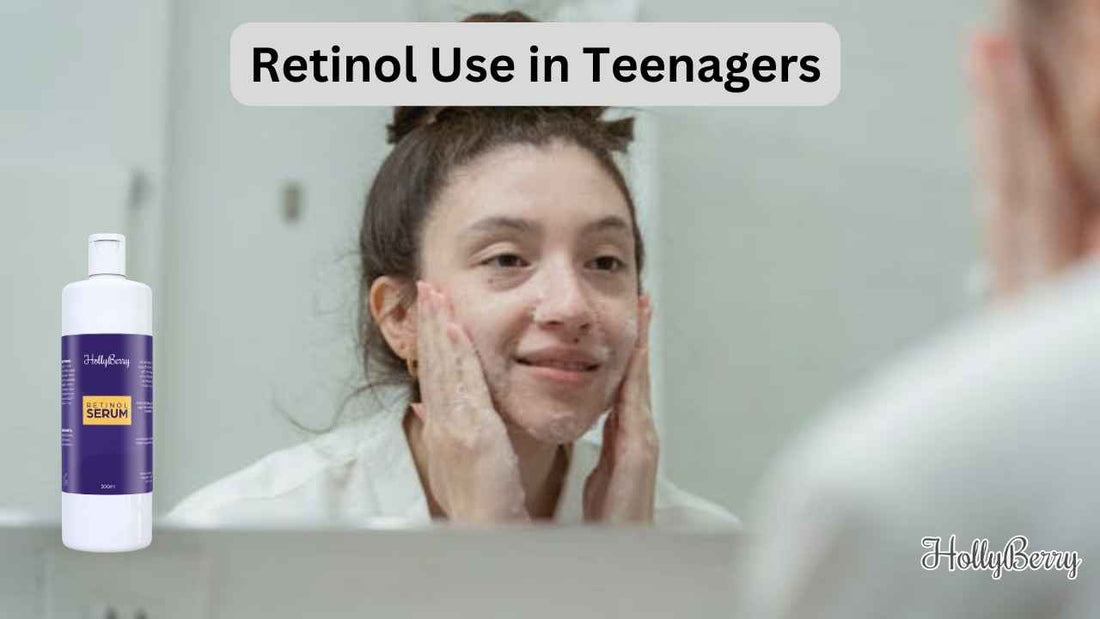
Retinol Use in Teenagers
Share
Benefits and Precautions Explained

Experts recommend that teenagers maintain a simple skincare routine, focusing on cleansing, moisturising, and applying sun protection. However, the increasing popularity of retinol has led to curiosity about its potential use in adolescence. Some dermatologists suggest that retinol can help teenagers combat acne breakouts and regulate sebum production.
While this may provide relief for those experiencing the typical teenage breakouts, it is essential to approach retinol use with caution.
When considering retinol use in teenagers, it is crucial to ensure the application of retinol-containing products is appropriate and informed. Overusing retinol or applying it in high concentrations could lead to skin irritation and sensitivities, which exacerbates existing skin issues.
As with any skincare product, consulting a dermatologist is always advised before introducing retinol into a teenager's regimen to ensure its safety and efficacy.
Benefits and Risks of Retinol for Teenagers
Acne and Blemish Control
Retinol can be particularly beneficial for teenagers struggling with acne. Its ability to regulate oil production in the skin helps to reduce breakouts.
Additionally, retinol aids in speeding up the skin's natural cell turnover rate, which not only helps control acne but also evens out the skin's pigmentation.
Long-Term Anti-Ageing Effects
Introducing retinol into a skincare routine from a young age can offer long-term benefits by preventing the early onset of wrinkles and fine lines.
As a derivative of vitamin A, retinol aids in the stimulation of collagen production, which contributes significantly to the maintenance of the skin's elasticity. This helps to delay signs of ageing for a more youthful appearance.
Potential Side Effects
While retinol offers numerous benefits, it may also cause some side effects, particularly for those with sensitive skin. Common side effects include:
- Redness: Retinol can cause mild to moderate redness, especially during the initial weeks of use.
- Peeling: The process of increased cell turnover may lead to the shedding of the skin's surface, resulting in slight peeling.
- Itchiness: Retinol users may experience itchiness or irritation, particularly if the product concentration is too high for their skin type.
It is advisable to start with a lower concentration of retinol and gradually increase the potency to avoid these potential side effects.
Furthermore, teenagers should consult their dermatologist to determine the most suitable retinol product for their skin type and needs.

Order our serum here
Guidelines for Safe Retinol Use in Teenagers
Retinol, a derivative of vitamin A, offers various benefits for the skin, such as boosting collagen production, maintaining skin elasticity, and helping with blemishes and uneven pigmentation.
While retinol can be effective in treating teenage skin issues, it's essential to use it safely and appropriately.
Appropriate Concentration and Formulation
When introducing retinol to a teenager's skincare routine, it's crucial to select the correct concentration and formulation.
Start with a low concentration (0.025% - 0.04%) and gradually increase the strength, if necessary.
Retinol is available in various forms, such as serums, creams, and ointments, with each offering different levels of hydration and suitability for various skin types.
Follow these guidelines based on skin type:
- Oily skin: Choose a lighter formulation like a serum or gel.
- Dry skin: Opt for a retinol cream or ointment that provides moisturising benefits alongside retinol treatment.
Integrating Retinol into Skincare Routine
Introducing retinol into a teenager's skincare routine requires careful planning to ensure effective treatment without causing irritation. Here's a sample routine that can be adjusted based on the individual's skin type and needs:
- Cleanser: Start by cleansing the skin with a gentle, noncomedogenic cleanser.
- Retinol application: Apply a thin layer of the chosen retinol product to the entire affected area, not just visible spots. For sensitive skin, begin treatment at a lower frequency, such as three times per week, and increase to daily use as tolerated.
- Moisturiser: After allowing the retinol to absorb, apply a noncomedogenic moisturiser to help maintain hydration levels without clogging pores.
- Sun protection: Retinol can increase sun sensitivity, so during the day, it's crucial to apply a broad-spectrum sunscreen with at least SPF 30 to protect the skin.
Consulting with a Dermatologist
Before starting any retinol treatment in teenagers, it's essential to consult with a dermatologist.
They can provide personalised recommendations on the appropriate retinol concentration, formulation, and skincare routine based on the individual's skin type, needs, and medical history.
If over-the-counter retinol products don't provide the desired results, a dermatologist may recommend a prescription-strength retinol product or an alternative course of treatment.
